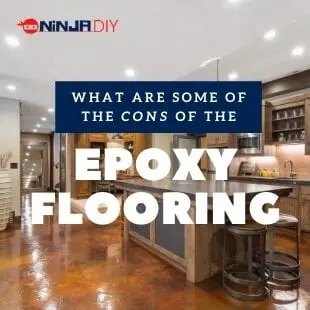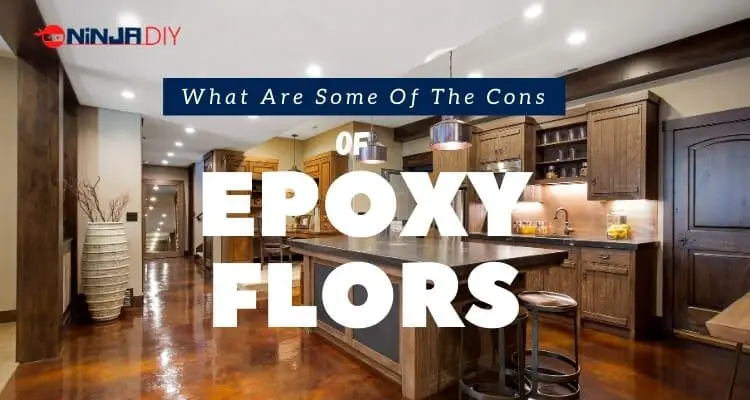Are you planning on adding a layer of epoxy flooring? While it might sound like a cost-effective and easy thing to do at first, there are many downsides to it that you’ll have to factor in before you go through with it.
Epoxy flooring is a time-consuming process that can be easily ruined by temperature conditions, moisture, improper mixing. It can be dangerous for people who are sensitive to strong fumes, not to mention that it isn’t meant for every floor type.
Before you go through with choosing epoxy flooring, we urge you to know what you’re getting yourself into before making your choice.
Keep reading to get the full low-down!
Top 10 drawbacks to epoxy flooring
Everyone loves a shiny and perfectly smooth floor, not to mention one that’s easy to clean.
But despite the benefits to epoxy flooring, there are a few disadvantages to consider:
1. Moisture retention
Unlike tiles, which have a degree of breathability, epoxy is non-permeable.

While this might seem like an advantage against spills, high humidity levels, vapors emitted from underneath concrete, or even concrete that isn’t fully dry can result in:
- Delamination
- The formation of bubbles beneath the surface of the flooring
- Mildew and moss growth between the flooring and concrete
- Preventing the epoxy from sticking to the concrete
That’s why before going with epoxy-based flooring, you’ll want to:
- Test the concrete for its vapor and moisture emission rate
- Ensure there are no faulty water pipes beneath the floor
- Make sure the concrete is fully dry
- Take into consideration if moisture sources such as lakes or rivers or are nearby
- Avoid epoxy flooring is generally damp areas such as basements
Although humidity-related issues might seem like a deal-breaker, it’s nothing that a layer or 2 of moisture-controlling systems can’t fix.
2. Cracking
Epoxy floors can withstand a lot of pressure — provided the concrete underneath them is of good quality.

It might seem trivial, and that there’s no real difference between the kind of concrete you’re using since you’ll cover it up with epoxy.
However, the fact is that low-quality concrete easily cracks over time, which will break away the epoxy or cause visible cracks from the underlying cement.
Cracking isn’t just limited to the type of cement you’re using; excess heat can also damage epoxy flooring while it’s still wet after a pour and cause it to shatter due to the resin base and curing agent reacting to the extreme temperatures.
3. Long preparation process
Even though epoxy is best known for its smooth and shiny look, without preparing the surface beforehand, the results can be disastrous.

To get the perfect coating, you need to go through the time-consuming process of:
- Grinding the floor to be even
If the surface you’re applying the epoxy to isn’t flat or already has cracks, no amount of coating layers will hide the imperfections of the floor beneath. On the other hand, a completely smooth floor without pores will not allow the epoxy to bond to the concrete’s surface.
- Degreasing & cleaning the floor
Concrete contaminated with grease or oil will act as a resistant barrier that prevents the epoxy from bolding. To ensure your coating will stick, you’ll need to make sure the concrete is thoroughly cleaned with a solvent detergent or through acid etching.
- Removing debris with a vacuum or blower
Unless you like seeing dust or gravel glued permanently into the flooring, you’ll want to make sure the floor is spotless from even the tiniest particles.
4. Long curing times
Epoxy can take several days to dry, and that’s just for the first layer before applying the second coating.

This can make epoxy flooring highly inconvenient in areas such as offices or warehouses.
The reason is that the timeframe for the flooring to dry can be anywhere from 24 hours to several weeks, depending on the product used and temperature conditions.
Even when the epoxy coating dries up on the surface, that doesn’t necessarily mean that it’s completely dry from the inside, which is why before you apply the second layer of epoxy coating, you’ll need to make sure that the first layer has completely dried up.
Otherwise, the first layer’s humidity will eventually evaporate into the second layer and result in a wrinkly appearance that can easily break off.
Patience is vital for epoxy flooring and even more so when you factor in concrete which requires 28 days at the very least before you can begin applying the epoxy.
5. Strict mixing requirements
Epoxy is made from two components:
1) The resin
2) The hardener
You should always keep in mind that every brand of epoxy coating differs in requirements.

Failing to stick to a specific product’s mixing ratios, directions, or waiting time often leads to a mess that either won’t dry up or will remain sticky long after you apply the coating.
This means you’ll have to remove the epoxy and redo the entire coating process all over again.
The main rules to keep in mind while mixing epoxy’s components are to:
- Stick with the proportions listed by the epoxy’s manufacturer
- Use a mixing machine instead of manually mixing
- Factor in temperature variables that could cause a component to dry faster
6. Toxic smells
While epoxy is a safe material once it’s dried up, it’s a whole different story while it’s still wet.

When the epoxy is in the curing process, the emitted vapors can be hazardous if exposed for too long, especially for people with respiratory issues such as asthma who should be nowhere near it.
The same applies to anyone who’s doing the floor work.
Masks, protective gear, and safety goggles are essential to avoid the risks associated with prolonged exposure to the smell of epoxy.
For these reasons, it’s essential to ensure that any room having epoxy floors installed should be adequately ventilated or at the very least have the AC on to dissipate the fumes.
Especially since walking into a sealed-off room with drying epoxy can result in a hazardous intake of suffocating fumes.
7. Slipperiness
Since epoxy floors have a smooth, seamless, and non-permeable surface, they can be as smooth as glass, meaning that any spilled liquid can turn dry epoxy floors into a slippery hazard, particularly in a home with kids.

It’s often not recommended to have epoxy flooring in public places; however, adding silica sand, colored quartz, or polymer grit will add a layer that will prevent the surface from being slippery, but at the cost of a smooth and shiny finish.
8. Unsuitable for non-concrete floors
In theory, you can apply epoxy to any surface, but whether it sticks or not is a whole different situation.

Epoxy flooring is mainly used over concrete since concrete doesn’t shift from its place (as opposed to wood which can contract) and that non-porous surfaces aren’t rough or grooved enough to allow the coating to hold in place.
While it is possible to sand off the surface of non-concrete floors and apply epoxy primer to create a foundation, it’s generally not recommended to do so since epoxy is a very rigid material once it dries up.
When combined with the flexibility of floors made out of wood or gypsum, it’s only a matter of time until the epoxy starts to crack or shatter from being walked on.
Not to mention that wooden floors absorb humidity and can result in epoxy forming blisters or bubbles.
9. One size doesn’t fit everything
Not all epoxy floorings are equal in strength, and that’s especially true for the kind of floor that you will apply it on and its use.

Epoxy flooring generally can withstand a lot of force if applied on surfaces correctly; however, an often-overlooked aspect in floor coatings is the thickness of the layers.
In most cases, epoxy floors can last for several years, but on floors that deal with a lot of friction, such as garages or warehouses where you drag heavy items, a thin coat of epoxy is a disaster just waiting to happen.
Which makes it all the more important to know what you expect your floors to withstand.
10. Difficult to remove
Epoxy is tough.
Very tough!

Its very nature makes it bind to concrete and become a part of the cement’s top layer to give it the durability it’s known for.
But as a result, removing it off your floors can be even more difficult than applying it in the first place since you will need heavy machinery to grind it off the floor.
If the epoxy is very thick, grinding it off could damage the concrete, meaning you may have to pour on new concrete depending on how difficult it is to remove the epoxy coating.
Wrapping up on the most common disadvantages of epoxy flooring
There’s no doubt about epoxy’s versatility.
From its seamless nature, ease of cleaning, and relative durability, it’s the perfect choice for many, but that doesn’t mean it’s always the right choice to go for, especially in public areas or where humidity can easily cause damage to it.
In situations where epoxy flooring is the right choice, always make sure to follow the manufacturer’s instructions.
Since the slightest mishap or wrong measurement could end up being a costly mistake that would result in having to redo the entire flooring with epoxy.
More information on epoxy flooring
https://www.paintersusa.com/blog/epoxy-flooring-benefits
https://brewfloors.com/prep-epoxy-coating/
https://www.astm.org/Standards/F3010.htm
https://woodepoxyworld.com/why-epoxy-cracks-and-how-to-fix-it/
https://blackrockindustrial.com/epoxy-flooring-not-all-epoxy-floors-are-created-equal/
Ninja Team Members Working On This Page

Adrian – Construction Professional
Construction Professional, driver, crane operator, handyman … As a construction pro I love to get creative and see things done with my hands coming to life. Here I share with you some of the things I learn and hopefully you’ll get something out of it. Enjoy 🙂



